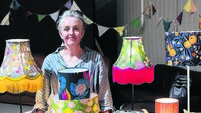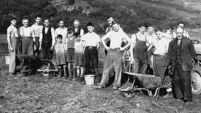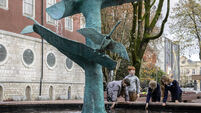Cork woman’s mission to fill her city with mighty oak trees

This follows closely on reports from the Hajj pilgrimage in Saudi Arabia where hundreds of people died from intense heat.
A heatwave in early June in Greece caused at least five tourists to tragically lose their lives, including the renowned TV doctor, Michael Mosley, who was found dead on the island of Symi close to Rhodes. He collapsed during a walk.
She has an ambitious plan to see her methods copied across the country, to ensure native woodland that was so much a part of our history can restore health and wellbeing across communities; provide shade from intense heat in cities; and offer a natural solution to climate warming.
Maria Young, Coordinator of Green Spaces for Health, Cork Healthy Cities, has that rare blend of optimism and enthusiasm for the future:
“I very much feel this is our time, and what an extraordinary time it is to be alive,” she said. “We have huge opportunity to make the change.
“I believe we will dream and do. When I think of the future, what is important for Green Spaces for Health is to keep our joy and excitement alive; to never get complacent about the miracle of our beautiful world and to keep doing everything we can to protect her at this time.”
Maria took some time recently to describe her vision for Cork Health Cities’ Tree Project.
During the pandemic lockdown, she met with Andrew St Ledger of the Irish Woodland League, who had founded a project called Forest In A Box. This is similar to the Duneman box project, a tree-growing system that uses a deep layer of leaf mould along with other organic material to propagate sapling trees. Andrew subsequently died suddenly in 2023.
Further discussions with founder of Hometree, Ray Ó Foghlú, inspired Maria to begin the process of propagating oak saplings in collaboration with local schools and green spaces identified by Cork Healthy Cities for development.
Maria was already working with students from Bishopstown Community School on a Reconnecting With Nature course.
In collaboration with Douglas/ Grange Men’s Shed, ten Duneman boxes 3ft x 1ft were constructed. The boxes were built with a raised mesh floor and a separate cover with mesh embedded in its frame. The mesh is essential to prevent mice, squirrels and birds dipping in and gobbling every acorn.
Once the acorns germinate and reach a height where they encounter the lid, the lid is no longer needed.
Boxes were placed in a range of national schools across the city - South Lee Educate Together, Glasheen Boys NS, St Marie’s of the Isle NS, and Greenmount NS and St Columba’s NS. Boxes were also left in the grounds of St Finbarr’s Hospital and Togher Community Garden.
The next task was to source leaf mould. Each autumn, groundsmen in St Finbarr’s Cathedral gather the leaves in a fenced area at the eastern side of the cathedral where it breaks down in the most wonderful loose compost, which Maria says is perfect for nuts because it is not too rich in nutrients.
‘The acorn comes with everything it needs, it likes the leaf mould as this creates a forest floor environment.’
The following year, in the autumn of 2023, on returning to the schools, Maria found germination rates consistently high, at roughly 80%. Not only that, they had survived the school holidays unattended.
In March and April this year, as the saplings were still dormant, they were transferred from boxes to pots that were sourced from discarded cut flower containers in Dunnes Stores.
The saplings need homemade compost made from leaf mould, regular household waste compost and chicken manure and a little seaweed dust - all bagged in Togher Community Garden by volunteers and delivered to all the locations where the saplings were propagating.
Schoolchildren transferred the saplings from the boxes into the pots one by one, mixing a little grit through as they went, and given the really important task of minding them until the summer break.
Two years in, how many saplings have survived? So far, Maria has collected almost 300 young healthy oak saplings from Glasheen National School, St Columba’s in Douglas, and St Marie’s of the Isle.
“We are really delighted at how well this project worked,” Maria told me. “We didn’t know what to expect. These trees are special, it is important to us that we find a good home for every one of them.”
Soon, the young trees will be delivered to Hometree, who plan to ensure most of them are planted in Cork in the coming autumn/winter. Ideally, Maria would love to see some of the schools who nursed the acorns and young saplings over two years, plant the young trees in their forever home.
“There was a big learning from the project,” Maria says. “All the participating schools loved it and want to engage again this autumn. We have requests for five more schools, four of which are on the north-side of the city.”
The children can make the leaf compost in schools. In time, the compost could also be made on site with food waste generated from the Free School Meals scheme, or from hot compost from grass and wood chippings.
This autumn, Maria would like to concentrate on other native Irish trees - perhaps hazel, hawthorn or alder. Green Spaces for Health plan to look around the city for old healthy trees from which fruit can be harvested for the next generation of trees.
“When you consider the abundance of fruit these trees produce, it really is a gift cast at our feet,” she said.
With Green Spaces for Health and Healthy Cities driving this plan, filled with energy, creativity and eternal optimism, the future of Cork and other Irish cities as a template for a resurgence of native Irish trees, seems increasingly bright.
Cork is a city of trees. ‘Where I sported and played ’neath the green leafy shade, on the banks of my own lovely Lee’ is its anthem. It is fitting that it is in this city that the native Irish oak is being revived - teaching its children to respect nature and challenging the climate crisis that is hurtling towards us.
Dr Catherine Conlon is a public health doctor in Cork.







 App?
App?







